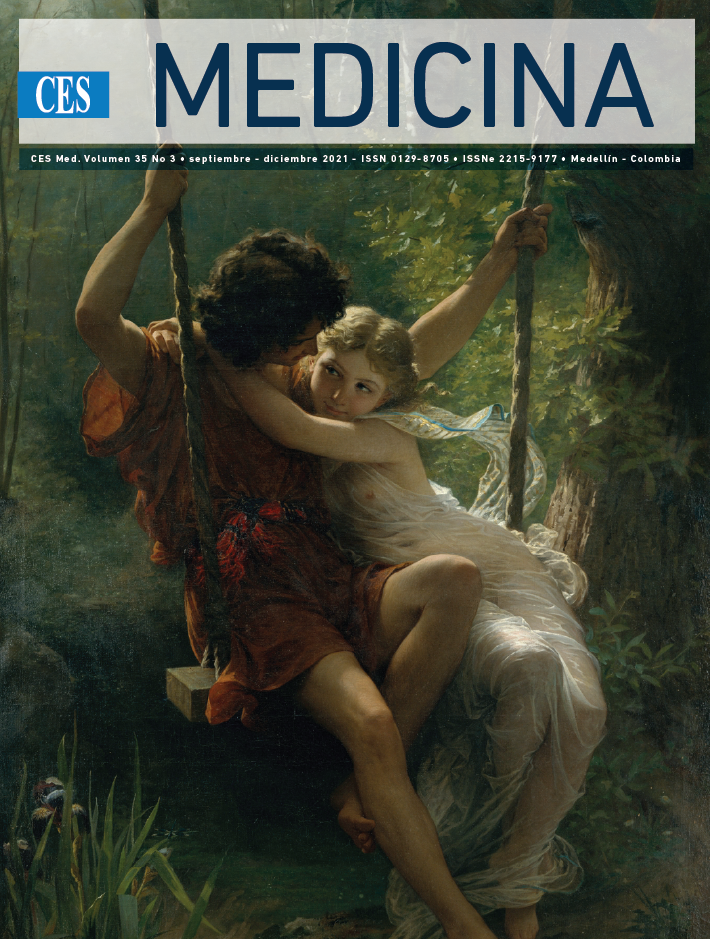Pseudomycosis due to opportunists: Lack of knowedge and diagnostic challenges
DOI:
https://doi.org/10.21615/cesmedicina.5125Keywords:
opportunistic infections, actinomyces, nocardia, prototheca, pseudomycosisAbstract
Infections generated by microorganisms that look like fungi but are not fungal are called pseudomycosis. This review addresses pseudomycosis by more frequent opportunists: actinomicosis, botryomycosis, nocardiosis and prototechosis, from an etiological, epidemiological and clinical perspective. In addition, clinical and paraclinical tools are reviewed to facilitate diagnosis, and and treatment guides are updated.
Downloads
References
Esposto AS. Infecciones oportunistas en pacientes adultos inmunocomprometidos no VIH. Actual en sida e Infectol. 2011;19(71):9–20.
Bonifaz A. Micología Médica Básica. 4a edición. Mexico, D.F.: Mc Graw Hill; 2012.
Boyanova L, Kolarov R, Mateva L, Markovska R, Mitov I. Actinomycosis: a frequently forgotten disease. Futur Microbiol. 2015;10(4):613–28. g
Padilla-Desgarennes C, Vázquez-González D, Bonifaz A. Botryomycosis. Clin Dermatol. 2012;30:397–402.
Mahendra P, Pratibha D. Nocardiosis: An emerging infectious actinomycetic disease of humans and animals microbiology. J Microbiol Microb Technol. 2016;1(2):4–7.
Wilson JW. Nocardiosis: Updates and clinical overview. JMCP [Internet]. 2012;87(4):403–7. Available from: http://dx.doi.org/10.1016/j.mayocp.2011.11.016
Mayorga J, Barba-Gómez JF, Verduzco-Martínez AP, Muñoz-Estrada VF, Welsh O. Protothecosis. Clin Dermatol. 2012;30:432–6.
Wang F, Feng P, Lin Y, Chen X, Xu D, Wang Z, et al. Human cutaneous Protothecosis: A case report and review of cases from Mainland China , Hong Kong , and Taiwan. Mycopathologia [Internet]. 2018;183(5):821–8. Available from: https://doi.org/10.1007/s11046-018-0292-3.
Valour F, Sénéchal A, Dupieux C, Karsenty J, Lustig S, Breton P, et al. Actinomycosis: Etiology, clinical features, diagnosis, treatment, and management. Infect Drug Resist. 2014;7:183–97.
Brown-elliott BA, Brown JM, Conville PS, Wallace RJ. Clinical and laboratory features of the Nocardia spp. based on current molecular taxonomy. Clin Microbiol Rev. 2006;19(2):259–82.
Moniruddin A, Begum H, Nahar K. Actinomycosis: An Update. Med Today. 2010;22(01):43–7.
Smith MH, Harms PW, Newton DW, Lebar B, Edwards SP, Aronoff DM. Mandibular Actinomyces osteomyelitis complicating florid cemento-osseous dysplasia: case report. BMC Oral Health [Internet]. 2011;11:21. Available from: http://www.biomedcentral.com/1472-6831/11/21
Rodriguez-Valero M, Bravo-Escobar GA, Prado-Calleros H, Vick-Fragoso R. Actinomicosis cervicofacial. An Orl Mex. 2011;56(1):43–6.
Bisero ED, Luque GF, Rizzo CN, Zapata AE, Cuello MS. Tuberculosis y actinomicosis. Un caso pediátrico de comorbilidad. Arch Argent Pediatr. 2016;114(4):233–6.
Pereira N, Cuevas P, Valencia C, Vega J, Gallegos I, Gonzalo J, et al. Actinomicosis torácica como diagnóstico diferencial de neoplasia: a propósito de un caso. Rev Chil Infectol. 2012;29(4):455–8.
Devaiah AK, Hoffman HT, Robinson RA, Carter K. Oral botryomycosis: a case report. J Laryngol Otol. 1997;111:77–9.
Katznelsen D, Vawter GF, Foley GE, Shwachman H. Botryomycosis, a complication in cystic fibrosis. J Pediatr. 1964;65(4):525–39.
Gutiérrez Dubois J, Alonso Martínez JL, Álvarez Frías MT, Abínzano Guillén ML, Munuera García L, Solano Remírez M. Nocardiosis pulmonar como causa de reagudizaciones en un paciente EPOC. An Med Interna. 2006;23(11):537–9.
Madeo MC, Maris Sacco NS, Stella MC, Videla E, Fernandez Blanco G. Nocardiosis diseminada. Med Cutan Iber Lat Am. 2016;44(1):48–51.
Bautista H, Lizarazo J. Nocardiosis diseminada en una paciente VIH negativa . A propósito de un caso de difícil tratamiento. Acta Neurol Colomb. 2015;31(3):267–75.
Seok JY, Lee Y, Lee H, Yi SY, Oh HE, Song JS. Human Cutaneous protothecosis: report of a case and literature review. Korean J Pathol. 2013;47(6):575–8.
Lass-Flörl C, Mayr A. Human Protothecosis. Clin Microbiol Rev. 2007;20(2):230–42.
Welsh O, Vera-Cabrera L, Salinas-Carmona MC. Current treatment for nocardia infections. Expert Opin Pharmacother. 2013;14(17):2387–98.
Larruskain J, Idigoras P, Marimón JM, Pérez-Trallero E. Susceptibility of 186 Nocardia spp. Isolates to 20 Antimicrobial Agents. Antimicrob Agents Chemother. 2011;55(6):2995–8.
Muñoz-Estrada VF, Mayorga-Rodríguez JA, Navarro-Hernández CA. Cutaneous protothecosis in immunosuppressed patients: a series of 14 cases. Med Cutan Iber Lat Am. 2018;46(1):13–6.
Haruna Shimagaki, Akihiko Yuki, Kiyoto Kimura, Daisuke Yuki, Hiroki Fujikawa, Naoya Shimizu, Riichiro Abe. Case of cutaneous botryomycosis in an 8-year-old immunocompetent boy with a review of the published work. J Dermatol. 2020;47(5):542-545.
Feng Zhao, Miaode Chen, Ying Fu. Multiple cutaneous infections caused by Prototheca wickerhamii. Case Reports J Clin Lab Anal. 2020;34(11): e23492. doi: 10.1002/jcla.23492.
Martínez-Barricarte R. Isolated Nocardiosis, an unrecognized primary immunodeficiency? Front Immunol. 2020;11:590239. doi: 10.3389/fimmu.2020.590239.eCollection 2020.
Downloads
Published
How to Cite
Issue
Section
License
Copyright (c) 2021 CES Medicina

This work is licensed under a Creative Commons Attribution-NonCommercial-ShareAlike 4.0 International License.
Derechos de reproducción (copyright)
Cada manuscrito se acompañará de una declaración en la que se especifique que los materiales son inéditos, que no han sido publicados anteriormente en formato impreso o electrónico y que no se presentarán a ningún otro medio antes de conocer la decisión de la revista. En todo caso, cualquier publicación anterior, sea en forma impresa o electrónica, deberá darse a conocer a la redacción por escrito.
Plagios, duplicaciones totales o parciales, traduccones del original a otro idioma son de responsabilidad exclusiva de los autores el envío.
Los autores adjuntarán una declaración firmada indicando que, si el manuscrito se acepta para su publicación, los derechos de reproducción son propiedad exclusiva de la Revista CES Medicina.
Se solicita a los autores que proporcionen la información completa acerca de cualquier beca o subvención recibida de una entidad comercial u otro grupo con intereses privados, u otro organismo, para costear parcial o totalmente el trabajo en que se basa el artículo.
Los autores tienen la responsabilidad de obtener los permisos necesarios para reproducir cualquier material protegido por derechos de reproducción. El manuscrito se acompañará de la carta original que otorgue ese permiso y en ella debe especificarse con exactitud el número del cuadro o figura o el texto exacto que se citará y cómo se usará, así como la referencia bibliográfica completa.
| Article metrics | |
|---|---|
| Abstract views | |
| Galley vies | |
| PDF Views | |
| HTML views | |
| Other views | |



